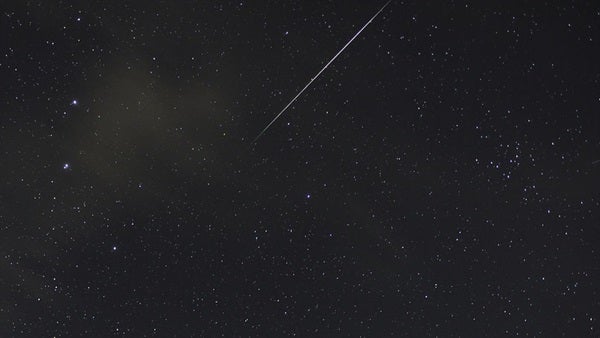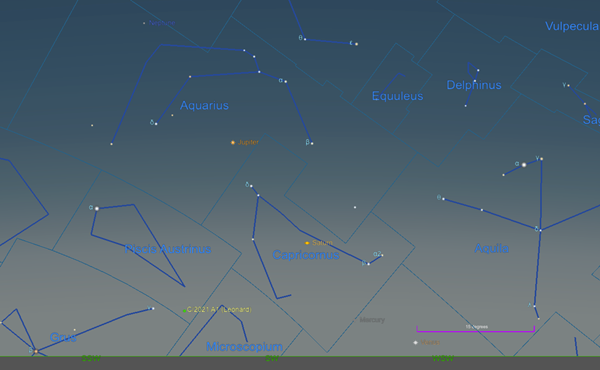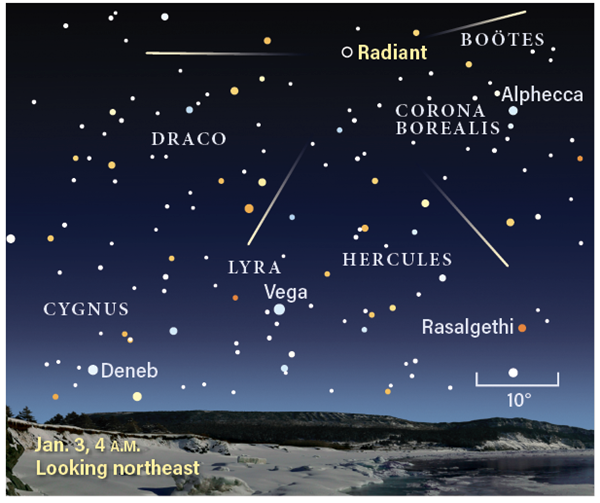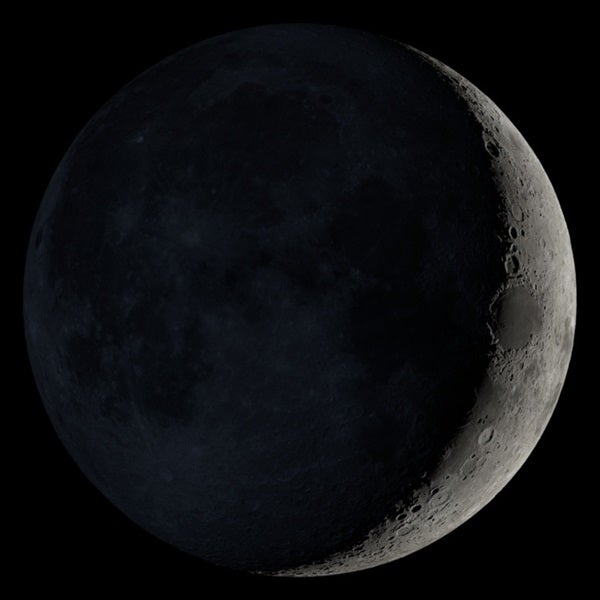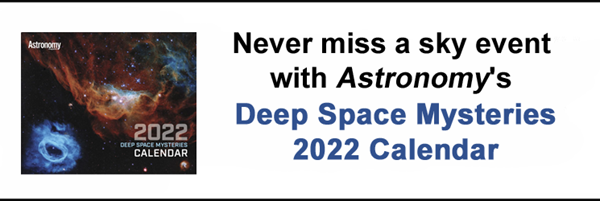Friday, December 31
The solar system gives 2021 a grand sendoff today, starting with a great early-morning tableau. Our Moon hangs 4° west of Mars in the predawn sky. An hour before sunrise, the pair is about 10° high in the southeast, joined by the bright red star Antares — the rival of Mars — to the south. Mars’ small disk shines at magnitude 1.5 — just a bit fainter than Antares’ magnitude 1.1 glow. If you didn’t know which was which based on their location in the sky, could you tell them apart?
Later today, well after they’ve set, the Moon will pass less 0.9° south of Mars at 3 P.M. EST.
But the show isn’t over yet. Four naked-eye planets are now visible in the evening sky at sunset: Venus, Mercury, Saturn, and Jupiter.
The brightest, magnitude –4.3 Venus, is lowest as the Sun disappears — 11° above the southwestern horizon. Magnitude –0.8 Mercury is 1° higher, slightly southeast of Venus. Saturn, which is a much fainter magnitude 0.6, is nearly 19° due east of Venus, higher in the sky and located in the constellation Capricornus. Highest in the sky, roughly 19° east of Saturn, is magnitude –2.1 Jupiter.
Complete the planetary lineup with Neptune and Uranus, also visible tonight. Neptune shares Capricornus with Saturn and is magnitude 7.8, while brighter Uranus (magnitude 5.7) is higher in the sky in Aries. Both are excellent binocular or telescope targets.
Sunrise: 7:22 A.M.
Sunset: 4:45 P.M.
Moonrise: 5:02 A.M.
Moonset: 2:39 P.M.
Moon Phase: Waning crescent (6%)
*Times for sunrise, sunset, moonrise, and moonset are given in local time from 40° N 90° W. The Moon’s illumination is given at 12 P.M. local time from the same location.
Saturday, January 1
What better way to welcome a new year that than with a glimpse of a bright comet? Reported around magnitude 4 earlier in the week, Comet C/2021 A1 (Leonard) sits in the southwestern portion of Piscis Austrinus. It’s 10° high at sunset, sinking lower as the minutes tick by and setting less than two hours later, around 6:30 P.M. local time. You’ll want to catch it as early as possible for the best views before it sinks too deep into the turbulent air near the horizon.
Tonight, Leonard is just a bit higher above the horizon than Mercury, which sits nearly 24° to its right [northwest] in Sagittarius. You’ll want to begin scanning the region with binoculars or a telescope shortly after the Sun sets. If your skies and view of the horizon are clear, you may be able to see the comet’s small, fuzzy round coma with the naked eye as darkness falls. By then, you can use the magnitude 4.3 star Iota (ι) Piscis Austrini as a closer guidepost — this star sits just 3.1° north-northeast of the comet tonight.
The Moon reaches perigee — the nearest point to our planet in its orbit — at 5:55 P.M. EST. At that time, our satellite will float just 222,471 miles (358,032 kilometers) away.
Sunrise: 7:22 A.M.
Sunset: 4:45 P.M.
Moonrise: 6:19 A.M.
Moonset: 3:33 P.M.
Moon Phase: Waning crescent (2%)
Sunday, January 2
New Moon occurs at 1:33 P.M. EST. That makes tonight ideal for observing fainter deep-sky objects like the Andromeda Galaxy (also cataloged as M31 and NGC 224). Some 2.5 million light-years away, it’s the largest galaxy in our Local Group of galaxies, which includes the Milky Way. From Earth, this large spiral is inclined at 77°, meaning it’s almost — but not quite — edge-on. That lets us still see its brighter bulge as well as its fainter spiral arms.
From a very dark site, you can see M31 with the naked eye. It sits 7.6° northwest of the 2nd-magnitude star Mirach (Beta [β] Andromedae). Even if you can’t see it on your own, any binoculars or telescope should afford you a view of this dim, oblong fuzzball. The more magnification you can get, the more of the galaxy you’ll see. The bright core will be easiest to spot, but some patience and averted vision can net you its wispy arms as well. Look also for two smaller companion galaxies — M32 and NGC 205 — nearby. The former is a small but bright bit of fuzz due south of Andromeda’s bulge, while the latter is larger but fainter, and located northwest of the bulge.
Sunrise: 7:33 A.M.
Sunset: 4:46 P.M.
Moonrise: 7:31 A.M.
Moonset: 4:38 P.M.
Moon Phase: New
Monday, January 3
The Quadrantid meteor shower peaks today with a maximum zenithal hourly rate of 120 meteors per hour. That rate, however, comes around midday when no meteors are visible. Instead, step outside early this morning around 4 A.M. local time, when the radiant, located in the now-defunct constellation Quadrans Muralis (modern-day Boötes the Herdsman), is more than 40° high in the northeast. With no Moon in the sky, clear weather will afford early risers quite the show. You can expect to see some 30 to 40 meteors per hour before sunrise, with a high potential for bright, memorable fireballs.
The brightest star in Boötes is Arcturus, but the Quadrantids’ radiant is on the opposite side of the constellation, some 32° northeast of this star. You can find the radiant more easily by dropping about 15.5° east of (down from) Alkaid at the end of the Big Dipper’s handle. As always, though, you’ll want to look a little ways away from the radiant for the best view, as meteor trails grow longer the farther from the radiant you spot them.
Alternatively, consider sitting back, relaxing, and enjoying the view livestreamed from Colorado by David Brewer, who will be broadcasting the event from January 2-3 and January 3-4, starting at 11 P.M. mountain time each night:
If you’re not up for an early morning but still want to do some in-person observing, you can instead view the Moon as it hangs near planet Mercury this evening. At sunset, the two are 4.6° apart in the southwest. Our satellite is a thin, 2-percent-lit crescent that may show off some earthshine: light that reflects off Earth to illuminate the shadowed portion of the Moon. Slightly higher in the sky, Mercury glows at magnitude –0.7 and spans 6″. The tiny planet is 71 percent lit.
The Moon will pass 3° due south of Mercury at 8 P.M. EST, not long after they set.
Sunrise: 7:22 A.M.
Sunset: 4:47 P.M.
Moonrise: 8:32 A.M.
Moonset: 5:52 P.M.
Moon Phase: Waxing crescent (2%)
Tuesday, January 4
Earth reaches perihelion — the closest point to the Sun in our planet’s slightly elliptical orbit around our star — at 2 A.M. EST this morning. We are now 91.4 million miles (147 million km) from the Sun.
Some might wonder why this is the coldest time of year on half the planet if we’re so close to the Sun. The answer is because of Earth’s tilt, which causes the seasons and means the Northern Hemisphere receives less light per unit area right now, even though we’re nearer to the Sun at this time of year than during the Northern Hemisphere summer.
The Moon passes 4° south of Saturn at noon EST. By sunset, the two are just over 5° apart in Capricornus. The Moon has now grown to a 7-percent-lit crescent and sits below the 3rd-magnitude star Deneb Algedi. Jupiter, shining a much brighter magnitude –2.1, is about the same distance above the star. Return to this region tomorrow night to see how much our satellite has moved as it travels around Earth on its month-long orbit.
Sunrise: 7:22 A.M.
Sunset: 4:48 P.M.
Moonrise: 9:21 A.M.
Moonset: 7:08 P.M.
Moon Phase: Waxing crescent (6%)
Wednesday, January 5
The Moon passes 4° south of Jupiter at 7 P.M. EST tonight. Now in the constellation Aquarius, our satellite is some 14 percent illuminated and features on its eastern limb (west on the sky) are visible. Most prominent is the circular Mare Crisium (Sea of Crises). Just above it is the large crater Cleomedes, while farther south on the lunar face is Langrenus, which sits at the eastern edge of Mare Fecunditatis (Sea of Fertility).
If you have a lunar map handy, you’ll notice that Mare Crisium appears farther south than on your reference. That’s because of libration, which causes the Moon to appear to “nod” up and down from month to month.
Sunrise: 7:22 A.M.
Sunset: 4:49 P.M.
Moonrise: 10:00 A.M.
Moonset: 8:22 P.M.
Moon Phase: Waxing crescent (12%)
Thursday January 6
Night owls can track down a stunning sight in Gemini the Twins tonight. Located less than 2.5° south-southeast of magnitude 3.5 Wasat (Delta [δ] Geminorum) is NGC 2932, also called the Lion Nebula. This object is a planetary nebula created by a dying Sun-like star. As these stars age, they puff off their outer layers, which then light up as photons from the stellar remnant still glowing in the middle hit them.
The Lion Nebula is roughly magnitude 9 and spans 15″ on the sky. It’s best seen with a telescope and the larger the aperture, the more detail you’ll see. The white dwarf at the center of the nebula is magnitude 10, making it relatively easy to spot. It’s surrounded by two shells of gas — one smaller, denser, and closer to the star, and a second that’s fainter, larger, and farther away. The inner shell creates the nebula’s namesake lion’s head, while the gas filaments forming the outer shell are its mane.
Sunrise: 7:22 A.M.
Sunset: 4:50 P.M.
Moonrise: 10:31 A.M.
Moonset: 9:33 P.M.
Moon Phase: Waxing crescent (21%)
Friday, January 7
The Moon passes 4° south of Neptune at 5 A.M. EST. Although not visible at the time, the pair can be caught in the evening sky, where they sit 7° apart an hour after sunset. Neptune, which requires binoculars or a small telescope to observe, is just less than 19° east-northeast of Jupiter. The solar system’s outermost planet is currently about 3.3° northeast of 4th-magnitude Phi (ϕ) Aquarii. Over the course of the month, it will slowly inch away from the star, ending January about 4° from this luminary.
Mercury reaches greatest eastern elongation from the Sun today at 6 A.M. EST, when it is 19° from our star. It is now shining at magnitude –0.5 and still visible in the evening planetary lineup in the west, even as Venus has disappeared for its inferior conjunction with the Sun tomorrow. At sunset, Mercury is now 14° high in Capricornus, just under 6° west-southwest of Saturn. Keep an eye on this region as it grows darker to see some nearby bright stars pop out against the background: Fomalhaut in Piscis Austrinus, Altair in Aquila, and Diphda in Cetus. Farther above the horizon, about 65° high an hour after sunset, is the Square of Pegasus, drawn from Markab, Algenib, Alpheratz, and Scheat.
Sunrise: 7:22 A.M.
Sunset: 4:51 P.M.
Moonrise: 10:58 A.M.
Moonset: 10:39 P.M.
Moon Phase: Waxing crescent (30%)

